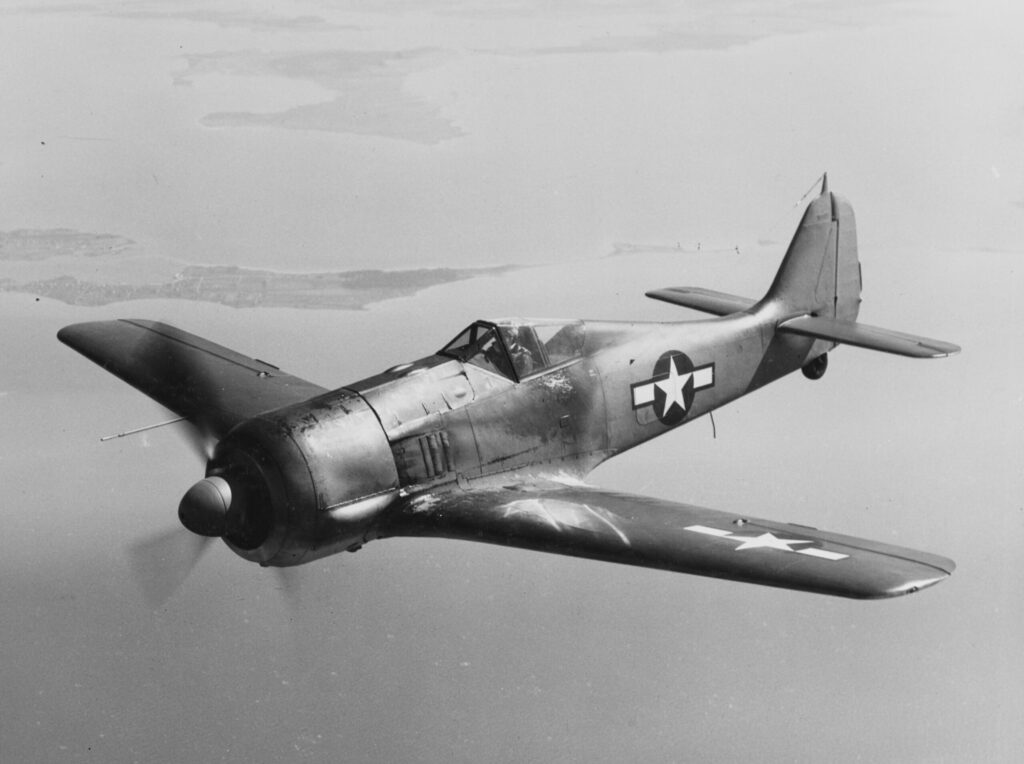
When the Second World War began in September 1939, the Luftwaffe had only one front-line, single-seat fighter: the Messerschmitt Bf 109.
In many ways, the 109 was an effective combat aircraft, but it had some notable and inherent design flaws that limited its usefulness and led to the Fw-190.
Most notable was the 109’s narrow-track undercarriage. The undercarriage legs were mounted in the narrow fuselage.
This simplified maintenance: the wings could be removed without the need for placing the aircraft on stands.
However, it also made the 109 tricky during taxiing, landing and take-off. Precise figures are disputed, but a substantial proportion of 109s were lost due to non-combat accidents that may be partly attributable to its unusual undercarriage design.
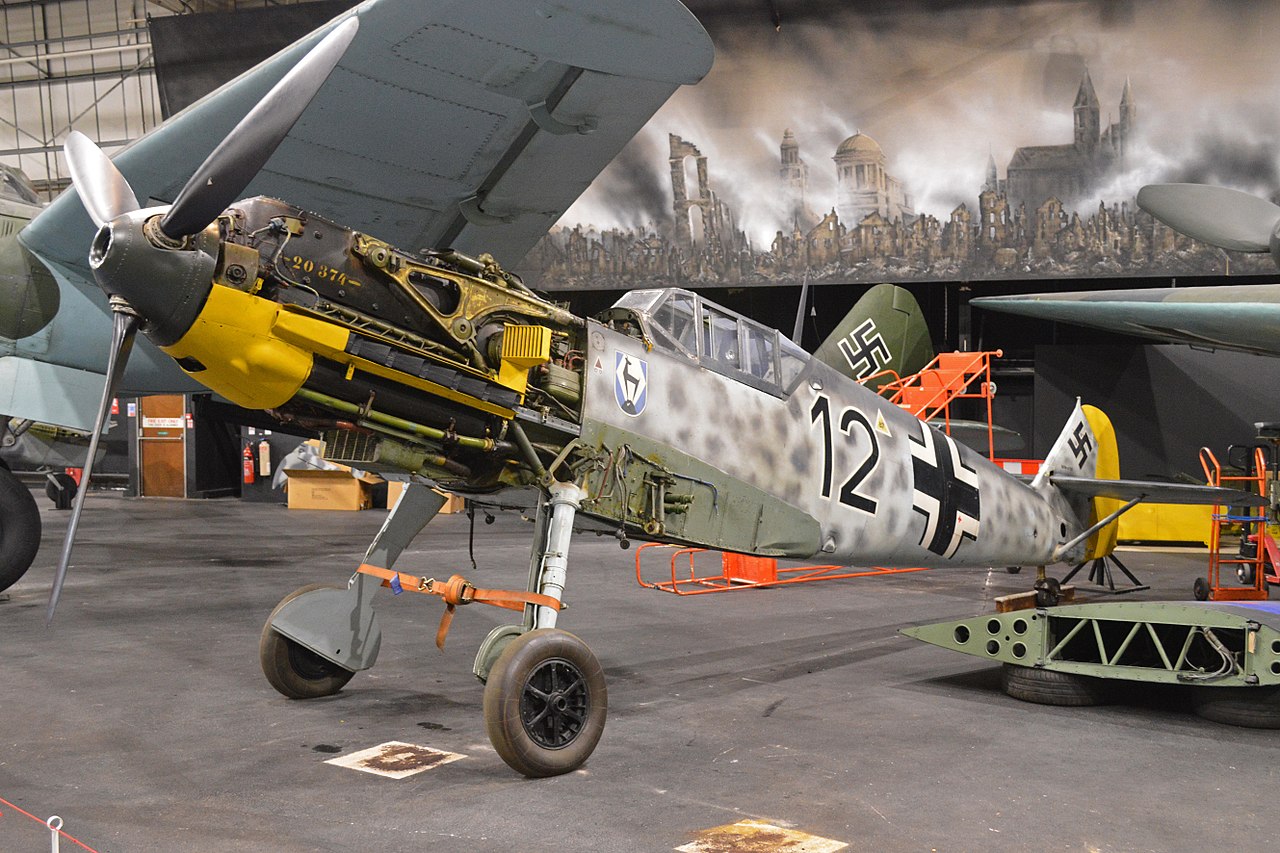
The 109 also had very thin wings which reduced drag but made if difficult to fit internal weapons. On most models, armament was slung under the wings on pods, which increased drag, negating the advantage conferred by the thin wings.
Finally, its cockpit was claustrophobic and the canopy used a complex design of framing and plexiglass panels that reduced visibility.
Even before the war began, these issues were recognised and a specification was issued for the design of another single-seat fighter than would succeed the 109 and overcome its inherent flaws.
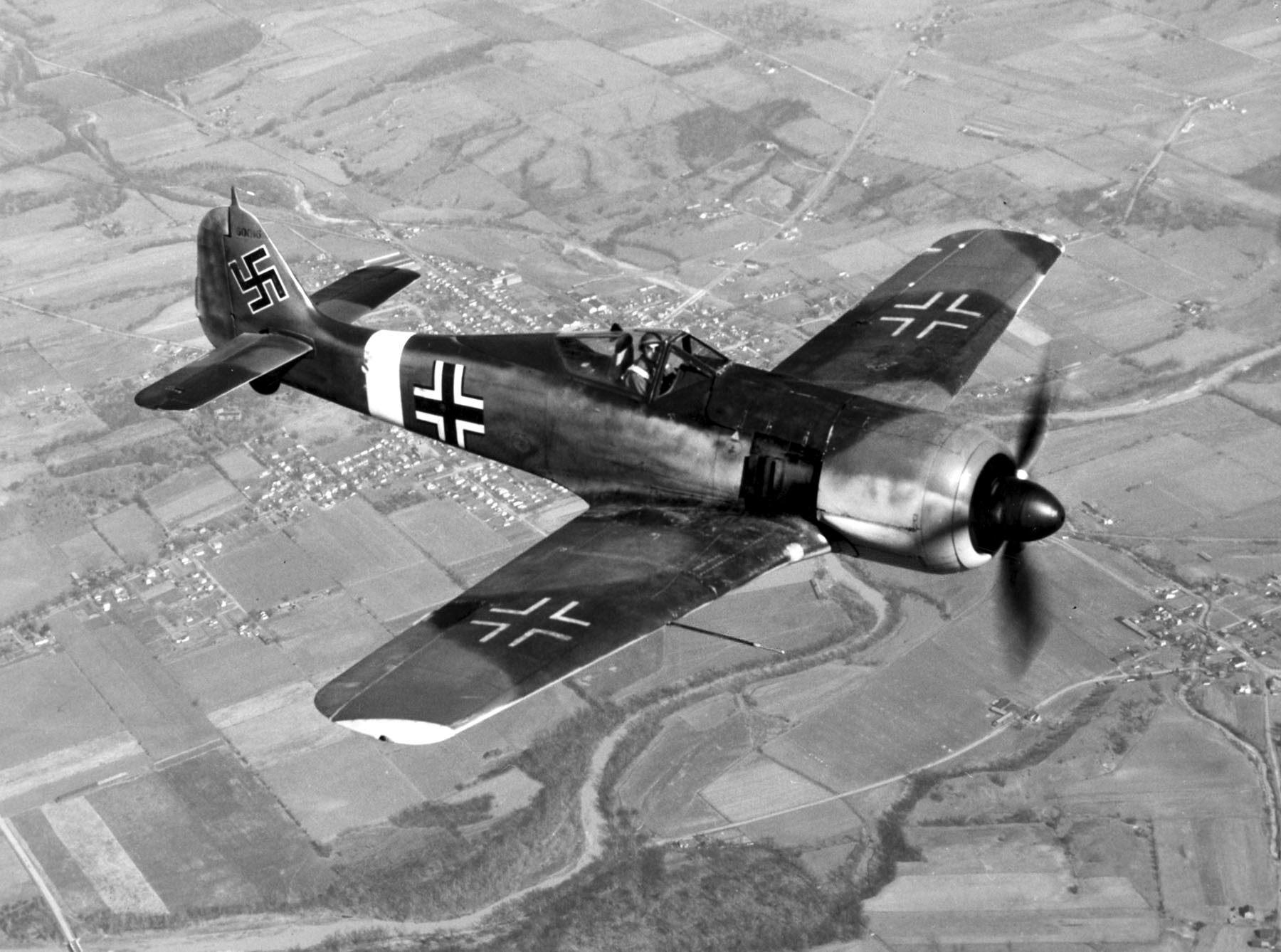
Focke-Wulf Fw-190 Background
Kurt Tank was born in 1898 in Bromberg-Schwedenhöhe, Germany. After serving in the German Army in World War One, he gained a degree in electrical engineering at the Berlin Institute of Technology and, in 1924, gained his private pilot’s license.
Tank became interested in aircraft design and joined the design department of the Rohrbach Metallflugzeug aircraft company where he was involved in the design of an early airliner, the Ro VIII Roland.
In 1930, he joined Bayerische Flugzeugwerke in Augsburg where he served under Chief Designer Willy Messerschmitt, the man who would go on to lead the design of the Bf 109.
Although they were the same age, it’s said that the two men did not get along: some accounts suggest that their brief period of working together led to a life-long feud.
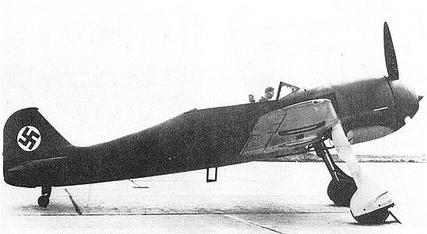
Whatever the truth, Tank left Bayerische Flugzeugwerke the following year when he was offered the position of design director and head of flight testing for Focke-Wulf in Bremen.
Read More: C-5 Galaxy – The Big Daddy
This was a very prestigious position for an engineer who was just 31 years of age at the time, and Tank quickly became involved in the design of influential aircraft including the Fw-200 Condor.
The airliner specifically designed for transatlantic journeys between Germany and the US (and later to become a very successful maritime patrol aircraft during World War Two).
In 1937, the Reichsluftfahrtministerium issued a contract for the design of a new single-seat fighter that would eventually replace the new Bf 109B that was then entering production and beginning to reach front-line units.

Focke-Wulf Fw-190 Design
The initial specification issued to Focke-Wulf Fw-190 specified a design capable of utilizing either one of two engines: the Daimler-Benz DB601 liquid-cooled V12 (as fitted to the Bf 109) or the BMW 139 18-cylinder, two-row, air-cooled radial.
Tank and his design team produced a design for a low-wing monoplane fighter that could use either engine.
After these were reviewed, the Air Ministry announced in the summer of 1938 that design work should continue on the version using the BMW radial engine.
A contract was placed for the construction of three prototypes.
Tank later explained the reasoning behind the design. He and his team wanted to produce a fighter:
“That could operate from ill-prepared front-line airfields; one that could be flown and maintained by men who had received only short training; and one that could absorb a reasonable amount of battle damage and still get back.”
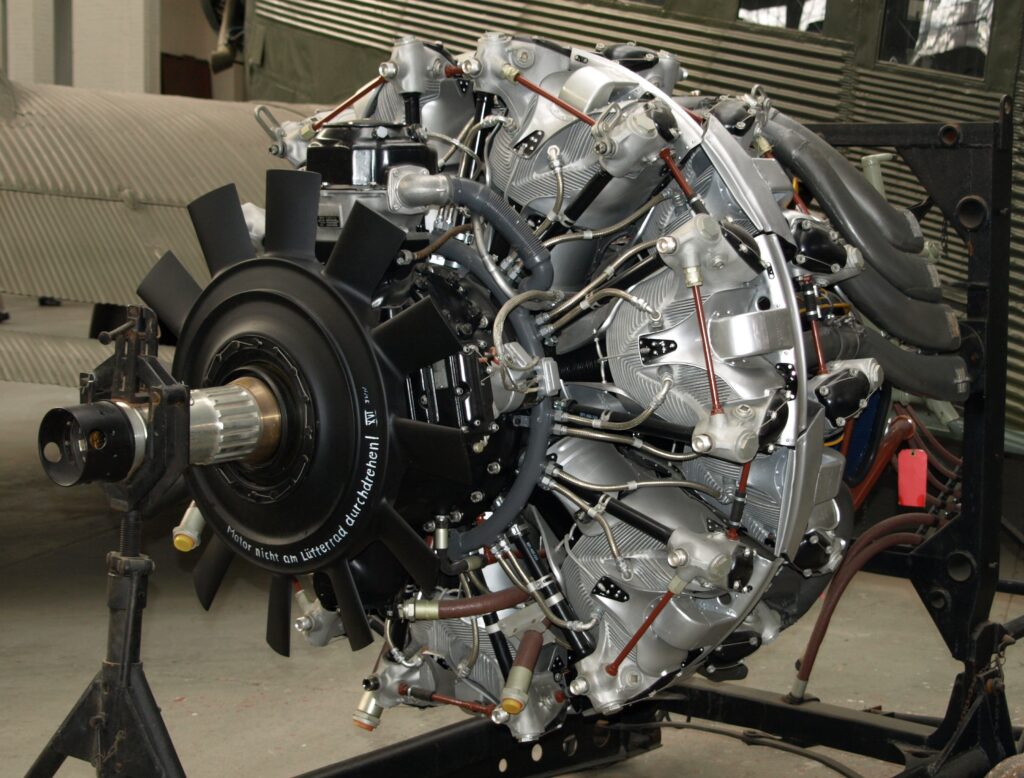
The decision to use the radial engine came as a complete surprise to Tank and his team.
In a combat aircraft, radial engines are a good choice because they lack the complex and vulnerable cooling systems of in-line engines, making them better able to resist battle damage.
However, radial engines are bulkier, reducing the pilot’s forward view and making it more difficult to design a streamlined fuselage.
It seems that the German Air Ministry was keen to avoid overburdening Daimler-Benz, who were already struggling to keep up with demand for the DB601, and that was why they insisted on a radial engine for the new fighter.
The new aircraft was given the RLM designation 190 and in June 1939, the initial prototype flew for the first time. The new Fw-190 incorporated several lessons learned from the 109.
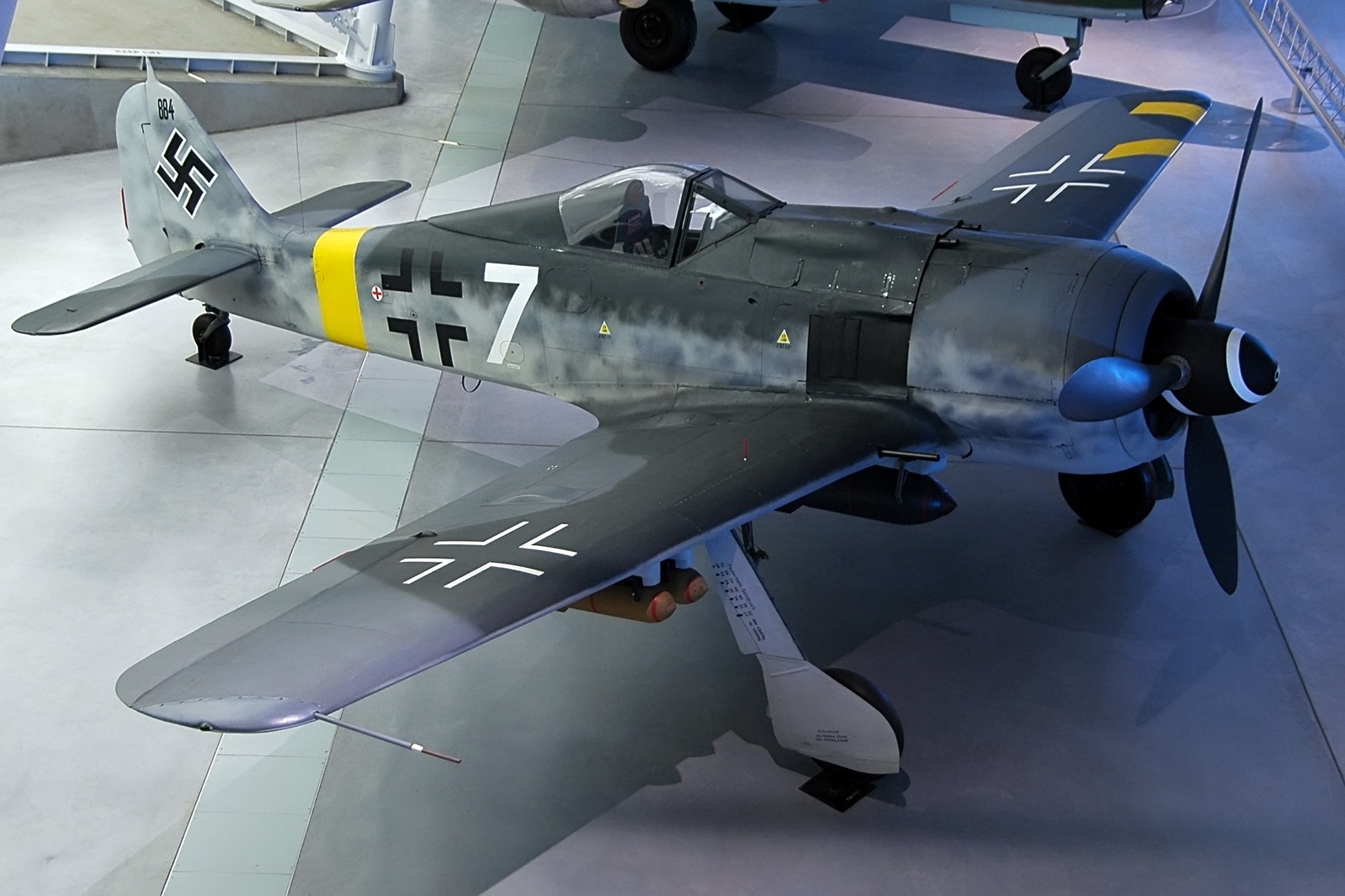
Its undercarriage retracted inwards from pivot points located well outboard in the wings, giving the new aircraft one of the widest-track undercarriages of any contemporary single-seat fighter.
The cockpit was spacious and the canopy was a single plexiglass bubble, giving superb all-around visibility. Flaps and landing gear were electrically operated, an unusual feature at the time.
However, the new prototype also had some problems. It was fitted with a large ducted spinner to assure cooling of the radial engine, but this was found to reduce performance.
It was quickly replaced with a conventional spinner that improved performance and did not cause overheating in the fan-cooled engine.
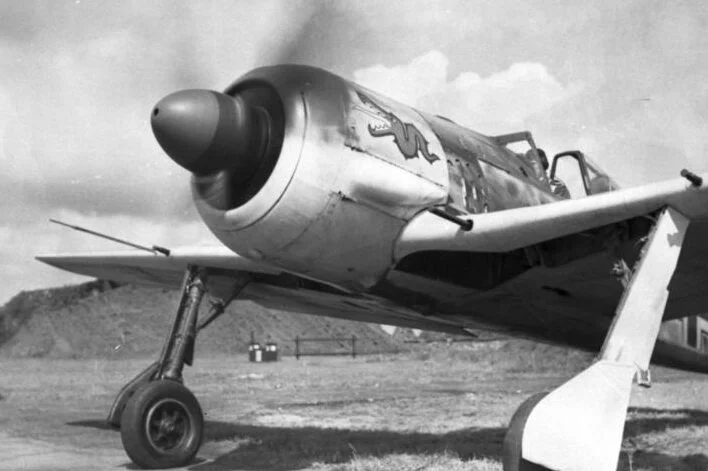
A second prototype was completed in October 1939, and this version was armed with two 7.9mm MG 17 and two 13mm MG 131 machine guns, all located in the inboard section of the wings.
However, it was also noted that the engine lacked power and a decision was made that all future versions would be fitted with the new, more powerful (and heavier) BMW 801C, 14-cylinder radial engine.
An order was placed for 18 pre-production aircraft, designated Fw-190 A-0. These were to be used for flight and armament testing before full-scale production.
This version was armed with four 7.9mm MG 17 machine guns, two on the engine cowling and two in the inboard section of the wings.

Focke-Wulf Fw-190 Production
Early flight testing of the pre-production version involved dealing with continuous problems with overheating on the rear bank of cylinders on the new engine.
In a few cases, the engines overheated so badly that they caused the ammunition for the cowling-mounted machine guns to explode!
Read More: Sukhoi Su-34 Fullback – Russia’s Supermaneuverable Bomber
This issue was so serious that there was the consideration of abandoning the whole Focke-Wulf Fw-190 project.
Instead, Tank and his team designed an improved fan-cooling system for the engine and BMW introduced an improved version of the engine, the 801C-1. These were used to create the next version, the Fw-190 A-1.
Tank also began work on the Kommandogerät, an electro-hydraulic system that provided automatic control of mixture setting, propellor pitch, fuel flow, ignition and operation of the supercharger.
This was to ensure that the engine was always in an optimal setting for the altitude at which the aircraft was flying, though it would be almost two years before this was fitted to operational aircraft.

Several Focke-Wulf Fw-190 A-1s were provided to JG 26, then based in France, for what was effectively combat testing.
Overheating engines continued to cause problems (some engines overheated before the aircraft even got off the ground!).
The armament of four machine guns was considered inadequate, but overall, pilots were sufficiently impressed with the new fighter that it was decided to go ahead with what would effectively be the first true production version, the Fw-190 A-2.
This version finally addressed the overheating issue by introducing new cooling vents into the cowling. It also replaced the wing-mounted machine guns with 20mm MG 151 cannons.

An additional pair of 20mm FF cannons were also provided in some versions, located further outboard in the wings.
From the introduction of this version, the Fw-190 became unofficially known in Luftwaffe service as the Würger (Shrike, also known in English as the Butcher Bird).
Subsequent versions, the A-3 – A-5, introduced in 1942, featured a new and even more powerful BMW 801D-2 engine and, from the A-5, the possibility to use the aircraft in the “Jabo” ground attack role with the provision of underwing pylons for bombs and rockets.
The A-6 – A-10 versions, first introduced in April 1943, focused on the close support role, including additional armour and increased capacity for carrying bombs and rockets.
These became the main aircraft used by the Luftwaffe Schlacht (battlefield support) force and gradually replaced the existing Ju 87 dive-bomber.
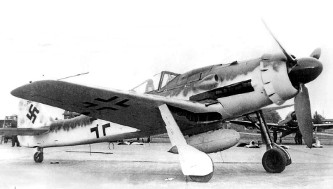
The Fw-190 A-8 became the most produced of all variants of this fighter with over 1,300 manufactured, including the R8 Sturmbock (Battering Ram), provided with even more frontal armour and intended for use in attacking US heavy bombers.
The Fw-190 D-9, which first began to appear in August 1944, was the only version of this fighter to be provided with a Jumo in-line engine. This proved to be faster and to have better climb performance than the A model.
The cowling machine guns were replaced with a pair of 13mm MG 131 cannons in the same position, supplemented by a wing-mounted 20mm cannons.
This was arguably the best of all variants of the Fw-190 in terms of performance, but fuel and spares shortages meant that though large numbers were produced, relatively few saw action.

Many were used to provide top cover for airfields operating the new Me 262 jet which was vulnerable during take-off and landing.
The final versions of this aircraft were the Fw-190F and G. Both were designed to be Schlachtjaeger (battlefield support fighters) and included additional armour beneath the engine and cockpit.
Read More: SEPECAT Jaguar – Jet Trainer turned Nuclear Attacker
The addition of this armour degraded overall performance but made these versions lethally effective in the close-support role.
The G version differed from the F in that it was designed specifically for long-range close support missions and the cowling guns were omitted to increase range.
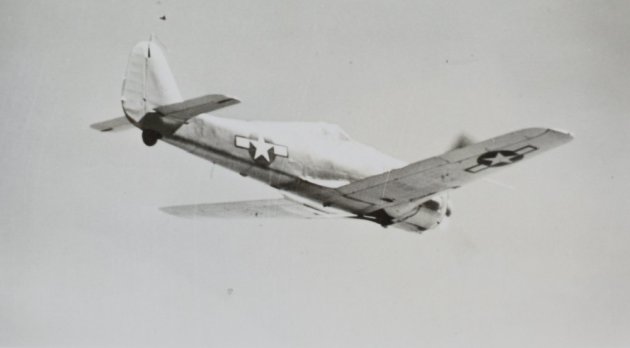
Why was the Focke-Wulf 190 so good?
The Focke-Wulf 190 was so good for several reasons. First, it had excellent maneuverability, which made it agile in the air. Additionally, it carried a strong set of weapons. It had two 7.9-mm machine guns in the engine cowling and four 20-mm cannons on its wings.
Because of these features, the Fw 190 became the top air-to-air fighter during the mid-war period.
Focke-Wulf Fw-190 in Combat
When the Fw-190 A-2 was first encountered by the RAF over France in September 1941, it caused consternation.
It was significantly faster than the Spitfire V at all altitudes and had superior roll and climb rates. Its mix of machine gun and cannon armament also proved to be lethally effective against British fighters.
For a short time, the superiority of the Fw-190 was so pronounced that some people came to believe that the usefulness of the Spitfire as a fighter was reaching its end.
However, the Spitfire IX, introduced in June 1942, finally achieved parity with the German fighter and the Griffon-powered Spitfire XIV, introduced in 1943, finally provided the RAF with a fighter superior to the Fw-190.
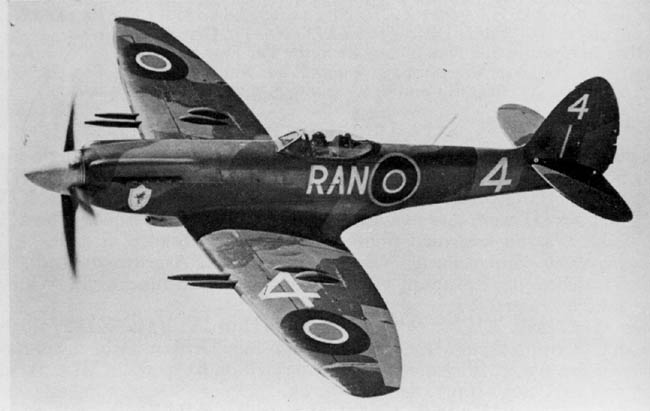
The most notable feature of the Fw-190 in service was the versatility provided by sound basic design. It was used not just as a fighter but also proved to be effective as a bomber-interceptor, ground-attack aircraft, long-range escort and even (in small numbers) as a night fighter.
Over 20,000 examples of all variants of this fighter were produced from 1941 – 1945. The Fw-190 was used extensively on the Eastern and Western fronts, in North Africa and over Germany to defend against Allied bombers.
Many German pilots (and their Allied and Russian counterparts) believed that the Fw-190 was the most effective German single-seat fighter of World War Two.

Conclusion
There was nothing radical about the Focke-Wulf Fw-190. However, it was a balanced design that took the lessons learned from the more fragile Bf 109 to create an aircraft that was rugged and effective in air superiority and ground-attack roles.
The large radial engine provided in most versions proved capable of absorbing combat damage while continuing to operate and it protected the pilot during a frontal attack.
Its sturdy, widely spaced main undercarriage made it capable of operating reliably from rough forward airfields and its bubble canopy allowed excellent situational awareness.
The sophisticated Kommandogerät automated engine control system introduced in 1943 significantly reduced pilot workload while ensuring optimal performance at all altitudes.

Overall, there wasn’t any one aspect of this aircraft that made it outstanding, but rather an aggregation of features that together made it one of the most effective combat aircraft of World War Two.
When it was first introduced, the Fw-190 had superior performance to most contemporary Allied fighters, though as the war progressed, its performance was reduced by the fitment of additional armour while new and improved Allied fighters first matched and then exceeded its ability.
Of course, it wasn’t perfect. The bulky engine reduced pilot visibility to the front, particularly while taxiing, and this caused problems and even the loss of some aircraft.
The initial engine overheating problems almost led to the cancellation of this fighter, but when these were finally addressed, it became a reliable and resilient aircraft.
Kurt Tank also went on to use the basic design of the Fw-190 to create arguably the best piston-engine fighter of World War Two, the Ta 152, but that is a story best covered in a separate article…
Focke-Wulf Fw-190 Specifications
- Crew: One
- Length: 8.95 m (29 ft 4 in)
- Wingspan: 10.506 m (34 ft 6 in)
- Height: 3.15 m (10 ft 4 in)
- Empty weight: 3,200 kg (7,055 lb)
- Max takeoff weight: 4,900 kg (10,803 lb)
- Powerplant: 1 × BMW 801D-2 14-cylinder air-cooled radial piston engine 1,700 PS (1,677 hp; 1,250 kW) and up to 1,980 PS (1,953 hp; 1,456 kW) for up to 10 minutes of emergency power
- Maximum speed: 652 km/h (405 mph, 352 kn) at 5,920 m (19,420 ft)
- Range: 900–1,000 km (560–620 mi, 490–540 nmi)
- Service ceiling: 10,350 m (33,960 ft)
- Rate of climb: 15 m/s (3,000 ft/min)